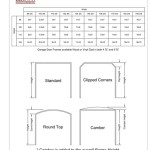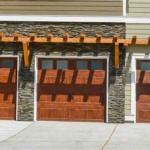Making Your Home Secure With Garage Door Incident Prevention
Home security is a multi-faceted concept encompassing various layers of protection designed to deter criminal activity and ensure the safety of inhabitants and their property. While aspects such as alarm systems, reinforced doors, and window security are frequently addressed, the garage door often represents a vulnerability that can be exploited. Understanding the potential for garage door incidents and learning how to prevent them is crucial for comprehensively securing a residence.
The garage door serves not only as a point of entry for vehicles but often also provides direct access to the home's interior. This direct connection makes it a prime target for burglars seeking a less conspicuous entry point than the front door. Moreover, garages commonly store valuable items, including tools, sporting equipment, and even vehicles themselves, making them attractive to thieves. This article explores the various types of garage door incidents, the vulnerabilities that facilitate them, and the practical steps homeowners can take to mitigate the risk and enhance their overall home security.
Understanding Common Garage Door Security Risks
The potential for garage door incidents stems from a range of vulnerabilities, both technological and physical. Understanding these risks is the first step in effectively preventing them. Several common scenarios can compromise garage door security.
Remote Control Vulnerabilities:
Older garage door openers often utilize simple codes that can be easily intercepted and duplicated with readily available technology. Burglars can use code grabbers or universal remote controls to gain unauthorized access to a garage. Even newer systems using rolling codes, while more secure, are not immune to sophisticated hacking attempts. The practice of leaving garage door openers visible inside vehicles parked outside also presents a significant risk. Thieves can easily break into a car, retrieve the opener, and gain access to the garage and, potentially, the house.Physical Security Weaknesses:
The structural integrity of the garage door itself and its surrounding frame are critical to its security. Weak or damaged doors, particularly those made of thin materials, can be easily forced open. Malfunctioning or poorly maintained locking mechanisms, including the handle and side locks, further weaken the security posture. Similarly, damaged or poorly installed weather stripping can provide leverage points for prying open the door. The emergency release cord, designed for manually opening the door during power outages, can also be exploited if it is easily accessible from the outside. A simple coat hanger or similar tool can be used to hook the cord and disengage the door's opener mechanism.Lack of Maintenance:
Regular maintenance is essential for ensuring the continued security of a garage door. Neglecting maintenance can lead to a variety of problems, including weakened springs, damaged rollers, and malfunctioning sensors. These issues not only compromise the door's functionality but also make it more vulnerable to forced entry. For instance, a broken spring can make it significantly easier to lift the door manually, while malfunctioning safety sensors can prevent the door from closing properly, leaving the garage exposed.Social Engineering and Opportunistic Theft:
Homeowners may unknowingly contribute to garage door vulnerabilities through careless behavior. Leaving the garage door open unattended, even for short periods, provides an open invitation to opportunistic thieves. Similarly, advertising expensive items stored in the garage through open doors or visible packaging can attract unwanted attention. Sharing garage door opener codes with untrusted individuals or failing to update codes when moving into a new home also increases the risk of unauthorized access.Implementing Proactive Security Measures
Addressing the identified risks requires a proactive approach that combines technological upgrades, physical security enhancements, and responsible homeowner behavior. Implementing these measures significantly reduces the likelihood of garage door incidents and strengthens the overall security of the home.
Upgrading Garage Door Technology:
Replacing older garage door openers with newer models that utilize rolling code technology is a fundamental security upgrade. Rolling codes generate a new access code each time the opener is used, making it significantly more difficult for thieves to intercept and duplicate the code. Consider openers with advanced features such as smartphone connectivity, which allows remote monitoring and control of the garage door. These systems often provide real-time notifications when the door is opened or closed and allow users to control the door from anywhere with an internet connection. Installing a battery backup system ensures that the garage door can still be operated during power outages, preventing unauthorized access due to a disabled opener.Strengthening Physical Security:
Reinforcing the physical structure of the garage door is crucial for deterring forced entry. Replace weak or damaged doors with solid core or steel-reinforced doors that are more resistant to physical attacks. Install heavy-duty locking mechanisms, including side bolts and deadbolts, to secure the door to the frame. Consider adding a garage door shield, which is a metal plate that covers the emergency release cord, preventing it from being manipulated from the outside. Install window security film on any windows in the garage door or garage itself. This film makes it more difficult to break the glass and gain access. Ensure that the weather stripping around the door is in good condition and properly installed to prevent leverage points for prying.Maintaining and Inspecting Regularly:
Regular maintenance is essential for ensuring the continued security and functionality of the garage door. Inspect the door, springs, rollers, and cables for any signs of wear or damage. Lubricate moving parts regularly to ensure smooth operation and prevent unnecessary strain. Test the safety sensors to ensure they are functioning correctly. These sensors should prevent the door from closing if an obstruction is detected. Adjust the door's balance regularly to ensure it opens and closes smoothly and evenly. If any issues are identified, promptly repair or replace the affected components. Consider scheduling professional maintenance inspections at least once a year to identify and address any potential problems before they compromise security.Practicing Responsible Security Habits:
Even with technological upgrades and physical security enhancements, responsible homeowner behavior is crucial for preventing garage door incidents. Never leave the garage door open unattended, even for short periods. Store valuables out of sight, and avoid advertising expensive items stored in the garage through open doors or visible packaging. Secure the emergency release cord inside the garage to prevent unauthorized access. Remove garage door openers from vehicles parked outside, or use a visor clip that conceals the opener. Consider using a smart home system to monitor and control the garage door remotely. These systems often provide real-time notifications when the door is opened or closed and allow users to view live video feeds of the garage. Educate all family members about garage door security best practices.Responding to Garage Door Incidents and Enhancing Overall Security
Despite preventative measures, garage door incidents can still occur. Knowing how to respond to these incidents and taking steps to improve overall security is crucial for minimizing potential damage and preventing future occurrences.
Responding to a Break-in:
If a garage door break-in is suspected or discovered, the first priority is personal safety. Do not enter the garage if there is any indication that the perpetrator may still be present. Contact law enforcement immediately and report the incident. Document any damage and losses thoroughly, including taking photographs and videos. File an insurance claim for any stolen or damaged property. After the police have completed their investigation, secure the garage by repairing or replacing the damaged door, locks, and any other compromised security features. Consider increasing security measures, such as installing additional lighting or a security camera, to deter future incidents.Enhancing Overall Home Security:
Garage door security is just one aspect of overall home security. Consider implementing a comprehensive security system that includes features such as door and window sensors, motion detectors, and security cameras. Install exterior lighting to illuminate potential entry points and deter intruders. Trim bushes and trees around the garage and other vulnerable areas to eliminate hiding places. Join a neighborhood watch program to increase community awareness and cooperation in crime prevention. Regularly review and update security measures to adapt to evolving threats. Consider consulting with a security professional to assess vulnerabilities and implement tailored security solutions.Leveraging Technology for Real-Time Monitoring:
Modern technology offers several tools for real-time monitoring of garage door activity. Consider installing a smart garage door opener with built-in security features. These openers often provide real-time notifications when the door is opened or closed and allow users to view live video feeds of the garage. Integrate the garage door opener with a smart home system to enable remote control and monitoring. Use security cameras to monitor the garage and surrounding areas. These cameras can provide valuable evidence in the event of a break-in and deter potential intruders. Consider installing a smart lock on the interior door leading from the garage to the house to prevent unauthorized access to the home's interior.Regularly Reviewing and Updating Security Protocols:
Home security is an ongoing process, not a one-time fix. Regularly review and update security protocols to adapt to evolving threats and vulnerabilities. Conduct periodic security audits to identify weaknesses and implement corrective measures. Stay informed about the latest security technologies and best practices. Educate all family members about security awareness and prevention techniques. Encourage open communication about any security concerns or suspicious activity.By understanding the risks associated with garage door incidents, implementing proactive security measures, and responding appropriately to incidents, homeowners can significantly enhance the security of their homes and protect their families and property. A multi-layered approach that combines technological upgrades, physical security enhancements, and responsible security habits is essential for creating a safe and secure living environment.

Why Burglars Are Targeting Your Garage Racv

8 Ways To Improve Your Garage Door Security

28 Tips To Protect Your Home From Burglary Homeadvisor

Can Impact Rated Garage Doors Save Your Home In A Hurricane Or Tornado Real Estate U S News

Strengthen Your Garage Door Flash Strengthening Homes Safeguarding Families

Keeping Your Shed Or Garage Safe And Secure Crime Prevention Metropolitan Police

Damaged Garage Door Repair Or Replace Mile High S

20 Diy S To Make Your Home Theft Proof The Family Handyman

The Benefits Of Installing A High Quality Above Water Home And Garage Door Sailability Nsw

Why Does My Garage Door Open Again After Closing
Related Posts








